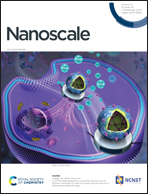Exploitation of mixed-valency chemistry for designing a monolayer with double ferroelectricity and triferroic couplings†
Abstract
Mixed-valence compounds possess both intriguing chemical and physical properties such as the intervalence charge transfer band and thus have been excellent model systems for the investigation of fundamental electron- and charge-transfer phenomena. Herein, we show that valence stratification can be a source of symmetry breaking and generating ferroelectricity in two-dimensional (2D) materials. We present ab initio computation evidence of the monolayer Cu2Cl3 structure with Cu ions being stratified into two separated layers of Cu(I) and Cu(II). Chemically, this unique monolayer not only entails lower formation energy than the bulk CuCl + CuCl2, but also enables the swapping of two valences through vertical ferroelectric switching, leading to a hitherto unreported chemical valencing phenomenon. Notably, the Jahn–Teller distortion of the Cu(II) layer results in another source of symmetry breaking and thus in-plane ferroelectricity. Apart from the valence swapping and self-contained double ferroelectricity, the monolayer's ferroelasticity is also coupled with in-plane ferroelectricity, while the monolayer's ferromagnetism is coupled with vertical polarization owing to the distinct magnetization of each Cu(I) and Cu(II) layer, thereby evoking the long-sought 2D triferroicity as well as triferroic couplings.



 Please wait while we load your content...
Please wait while we load your content...